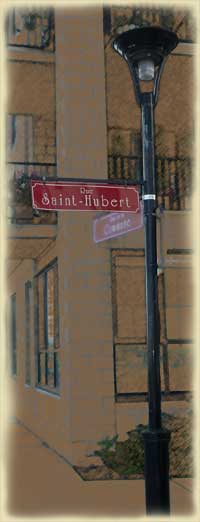Nicolas Hubert dit La Croix.

Nicolas Hubert and Marguerite Landreau.
Nicolas Hubert was born about 1611. He is said to be from La Rochelle, a city in France that was under siege for about 14 months in 1628 and saw its population decimated in the onslaught.
He and Marguerite Landreau were married 26 June 1644 in Notre-Dame in Fontenay-le-Comte, Vendée, part of Poitou. Marguerite had been baptized in that town 28 December 1623. Her parents were Jacques Landreau and Renée Minaud.
The couple had a son they named Nicolas who was baptized 15 October 1647 at Saint-Médard-des-Prés, Fontenay-le-Comte, but the boy is not mentioned in later records.
Foray to New France.
Nicolas travelled to Québec in 1649, perhaps to investigate the feasibility of bringing his family over. He was a skilled tailor, and craftsmen were in demand in the colony. Soon he returned to his wife in France, now living in the port city of La Rochelle where his son Jacques, our ancestor, was born in 1653. The following year the family sailed in a wooden ship to New France. It was the same year France's young king Louis XIV was coronated and began his long rule.
As a master tailor Nicolas was in a position to take on an apprentice to train in the trade. The daily attire of the rank and file were styles more closely attuned to the rigors of frontier life, buckskin leggings for men and shorter skirts for women which mimicked that of the indigenous population. But the latest fashions from France were in demand for Sunday services or when attending a social event. For women, tight corsets and low necklines off the shoulder were desired. Men wore long coats and long-sleeved white shirts with a cravat. Buttons made with a shank were used in addition to ribbons and ties to secure the garments. Hair was kept long and curled, with men parting it in the middle. They often pulled it back in a ponytail tied with a ribbon. Wigs made of horse or goat hair were commonly used to cover thinning hair. And the bigger the better. Wealthy people wore large hairpieces, thus adding "big wigs" to the lexicon meaning those of greater status.

Recensement.
The Crown conducted several censuses (recensement) during this period and they provide a window into the family. One child died in 1662 at the age of 16 months, another son named Nicolas. But their other children thrived.
1666: Nicolas was a tailor, age 55, living in Montréal with his wife Marguerite Landreau age 40. Their children were our ancestor JACQUES (12), Ignace (9), Elizabeth (7), Louis (3) and Jean (1), and one domestique engage or servant, Nicolas Ozanne (17).
1667: Nicolas, still 55, had 2 cows, and 8 arpents under cultivation, his wife Marguerite Landros, 42, their 5 children including JACQUES (13), Ignace (11), Isabelle (Elizabeth) (9), Louis (4), and Jean-Baptiste (2).
Though he would serve in the 17th squad of Militia of the Holy Family as a caporal to defend the colony, he, like many of the settlers, did not own a gun according to this census. He would arm for battle with axes or farm equipment.
Legacy.
Marguerite Landreau was 57 when she passed away on 29 October 1680 and was buried the following day.
In the 1681 census in Montréal Nicolas, 71 was a tailleur (tailor). He had acquired 2 fusils (guns) and had 3 bestes à cornes (horned beasts like cows or goats). Their children included our ancestor JACQUES, 27; Ignace, 23; Louis, 18; Jean, 16. (His daughter Elizabeth married Antoine Renaud five years before at age 16.) Over the years his sons had cleared more land for cultivation and had a good sized farm of 18 arpens under cultivation.
Nicolas not only left his children well established with land, he set them up with a foothold in the lucrative fur industry. Rue Saint-Hubert in Montréal commemorates the influential Hubert La Croix family. Nicolas Hubert dit La Croix died in Montréal on 29 October 1687.
- Image: author's collection
- www.fichierorigine.com HUBERT / LACROIX, Nicolas 440049
- Fichier Origine LANDREAU, Marguerite 440047
- Recensement 1666, 1667
- Jetté, René, Dictionnaire généalogique des familles du Quebec des origines à 1730 (Montréal: Les Presses de l'Université de Montréal, 1983
